Create an Issues
This is a guide to creating any type if issues in JIRA.
Check example issue to see how issues should be created: Example issue - DSCOM-41 (https://datastat.atlassian.net/browse/DSCOM-41)
Example Issue
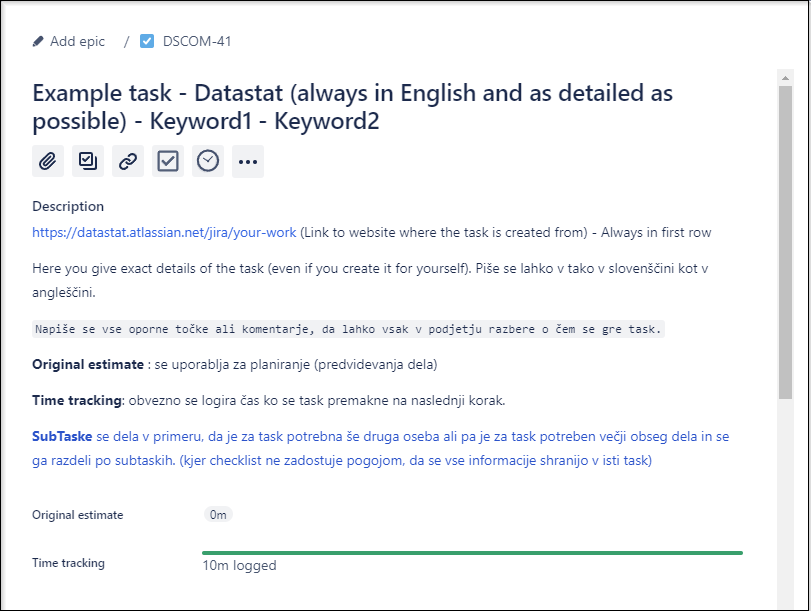
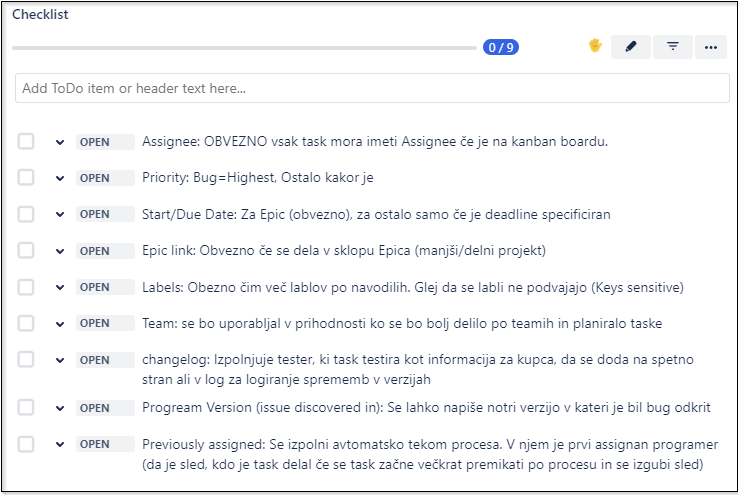
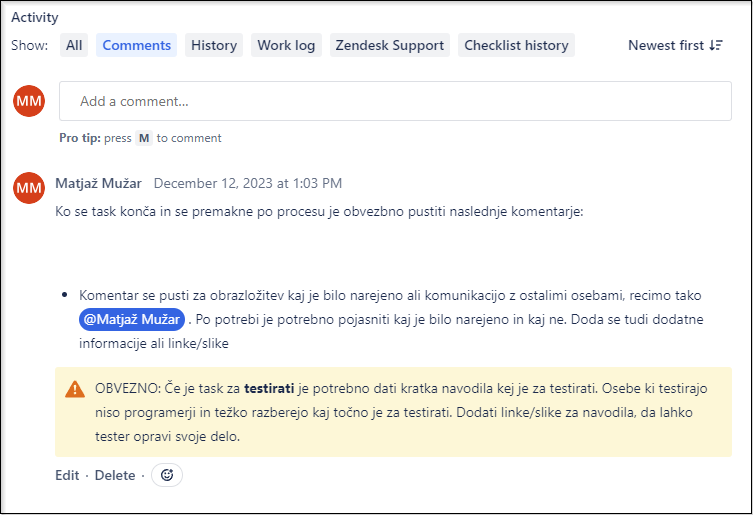
Create an issue/task
You can create an issue by clicking blue button Create on the top of the Jira Software screen or you can first go inside your project and then click Create button.
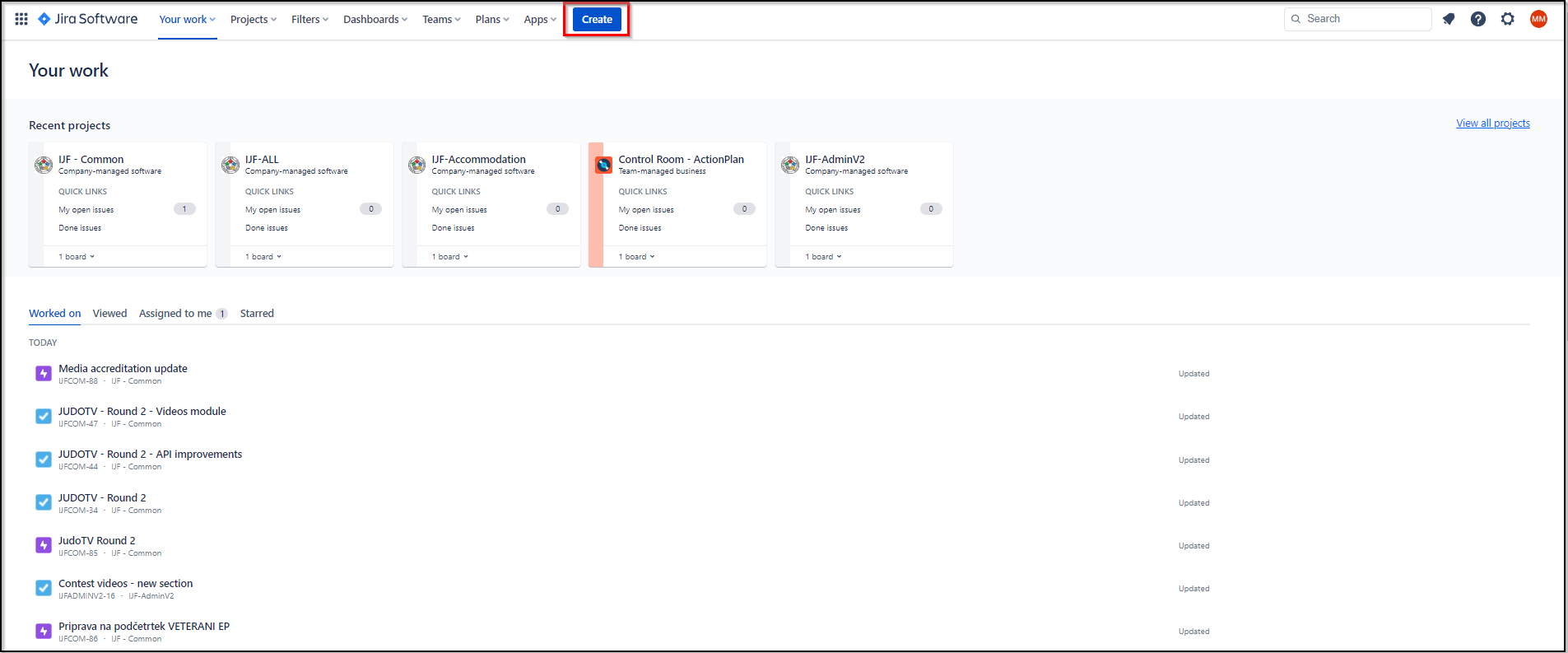
By creating task you have to insert data:
Project = select project in which you want to add task
Issue type = Choose your issue type
Status = Open or Backlog (Open if issue will be in work soon, Backlog if you do not know when the issue will be in work)
Summary = Type in short summary of issue (English preffered)
Description = Include a longer explanation of where the issue occured, why it occurred, and other explanations that will help programmers and testing teams to understand the issue. (Can be in Slovenian)
Linked Issues = if there are any linked issues you can add them here.
Assignee = add assignee or not (it can be added later when moving to InProgress)
Priority = Highest (work immidiatly or next thing), High (work is planned immidiatly when programmers are available), Medium (normal task when planned), Low (improvement or new feature), Lowest (documentation update, discussion, idea, ...)
Labels = add product (e.g. viewer, recorder, jmdesktop, ...) and others that are project specific (changelogs, data, ...)
Epic Link = We use epics for group of tasks that is worked by programmers. It can be topic inside of project or part of the project.
Start date and Due date = can be added on Plans or on Roadmap
Issue will be created in Backlog or Open status, depends on what you choose. You can also choose one of next statuses: Discussion, Documentation, Version or InProgress but Backlog and Open are prefered
When creating tasks, you have to create summary according to standard based on the type of the task.
- Epic
- Use few key words to explain epic
- Planning
CONCEPT - ...(explaining idea or concept of the epic or task)PREPARATION - ...(includes all details about preparation for work)MOQUPS - ...(includes all moqupes and design work)MEETING - ...(includes all meetings with clients and agreements)
- Task, Group Task, Subtask, Bug, Idea, Improvement
DATABASE - ...(database task - epic/parent required)API - ...(endpoint task - epic/parent required)FRONTEND - ...(frontend task - epic/parent required)DESIGN - ...(design task - epic/parent required)GUI - ...(gui task - epic/parent required)PROJECT NAME - ...(task without epic/parent. Example: Admin Files - ..., Account 2FA - ..., Scoreboard Client - ...)
Create a Sub-task
Sub-task as explained in Sub-task is a part of task and it is used to if task must be devided between multiple programmers to log work, communicate and plan or if Task must be devided on multiple tasks to have better overview.
Sub-task can only be created inside of a task or any other issue type.
Create a sub-task by clicking:
Create subtask inside of a task. Task will then be displayed as Subtasks category and listed inside of a task

Sub-task has the same layout as any of Default issue type.
Sub-tasks on Kanban
Sub-tasks will be shown on Task kanban cards, if you set it inside of settings.
Subtask on kanban is displayed as:
On the top of Subtask kanban card is name of the task, where the subtask is created. If there are more than 1 subtask and they are in the same status it will be shown as:
Choose the right issue type
Issue types are devided in 3 categories:
- Epic
- Task
- Sub-task
- Idea
- Improvement
- Planning
- Group task
- Bug
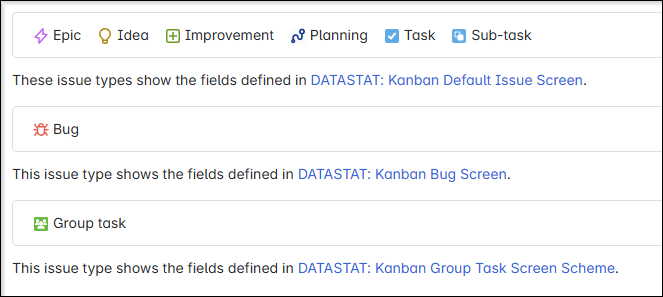
Epic
Epic must be created each time programmer or team works on the project. It describes part of the project or project task inside the project. It usally consists of multiple tasks or multiple stories containing multiple tasks and it has minimal duration of 1 week. (can be less in some cases)
Epic can be created with Create button on the top of the screen (same procedure as creating any task inside project) or can be created in Backlog
Backlog->EPICS->Create epic

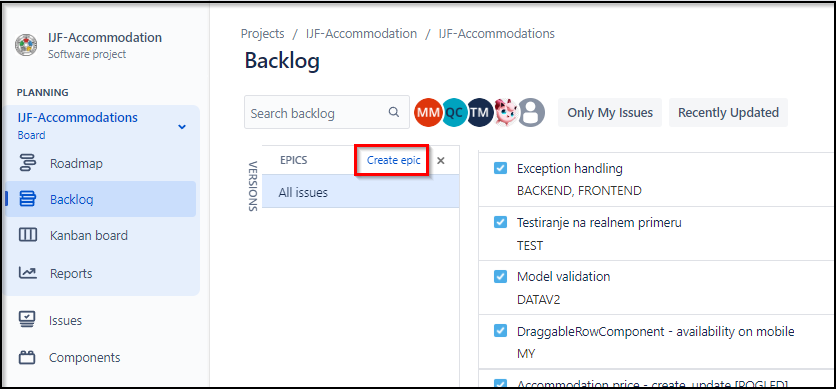
Epics are then seen in Roadmap as part of planning

And is displayed on kanban cards:
- Start Date
- Due Date
Planning Task
Planning task is created when the project is still in idea or preparation stage. Planning task include:
- Preperation stage
- Idea stage
- Moqups and design preperation
- Meetings with clients or internal meetings
- Database stucture preperation and ideas
- Detail worklog preperation
Group Task
Group Task can be created inside of epic when is there are many different tasks which are part of same group and we have multiple people working on it. So story is "small epic" which connects task of same group.
Group Task is created with same procedure as any task.
Task
Task is created for basic work of programmer. Task are presenting most of the created issues. They are created for day-to-day tasks, loging work or any work that is done on a project and cannot be classified as any other issue type.
Sub-task
Sub-tasks are part of one task. If multiple programmers work on 1 task they must create sub-tasks to log work and to use sub-tasks as communication of done work and work planned.
Sub-task = Task
Sub-task has the same value as Task but it is only created inside of Task.
For more information see Create a Sub-task
Idea
Idea is used for any new idea that comes along and need to be discuseed. Task marked as idea usually have low priority and need to be prioritized by team.
Improvement
Improvement is used when already existing function is upgraded or improved. This issue type has low priority too if not otherwised discussed inside of team.
Bug
Bug can be created same as any other issue.
Bug is defined as error or mistake in programming found by customer inside of production released program. It does NOT include ideas, improvements or new featuers.
Bugs have always the highest priority and must be necessery done untill the next release, if not communicated otherwise.
Marking issue as BUG it will automatically set the highest priority inside of issue
Create issue from Control-Room or Support Ticket
Sometimes issue is discovered during competition or by someone using the program.
In this case issue is created with the same procedure as any other ticket with few exceptions:
- Support issues and Control-Room issues must always have assignee
- If you don't know in which project ticket belongs you can check Choose Project. If you are still not sure you can always put it in Control room Project
- If you don't know who is the assignee you can always put project leader as assignee
- Support issues and Control-Room issues must always be highest priority
- Priority can or will be lowerd by assignee or project leader
- Support issues must have label:
SUPPORTand Control-Room issues must have label:CONTROL-ROOM